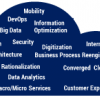Business Transformation Requires Transformational Leaders
Leadership and teaming skills are front and center in times of rapid change. Meet today’s constant disruption head on with expert guidance in leadership, business strategy, transformation, and innovation. Whether the disruption du jour is a digitally-driven upending of traditional business models, the pandemic-driven end to business as usual, or the change-driven challenge of staffing that meets your transformation plans—you’ll be prepared with cutting edge techniques and expert knowledge that enable strategic leadership.
Recently Published
As digital disruption accelerates, having an effective EA group is now more valuable to organizations than ever before. Digital transformation is essential, and the enterprise architect plays a critical role in its success.
In this article, we investigate ways to use enterprise architecture (EA) to deal with disruptive business models, either by supporting the transformation of your own business to deal with disruptors or starting new spin-off businesses that attack the disruptors head on. How can a company use its existing EA to address the challenges in disruptive business models?
This final Update in a four-part series on business architecture peers into the future, considering business architecture’s foundational role in establishing the cognitive enterprise.
Success can be achieved by groups of highly talented individuals — heroics in action — but only in certain situations for limited periods of time. This is not repeatable or sustainable. Striving for the goal of sustainable improvement requires a more structured approach supported by technology. This can enable teams of “mere mortals” to perform and feel like superstars.
This article focuses on equity-based crowdfunding, or crowd investing, which has become a promising instrument to help overcome SME liquidity issues, referred to as the early-stage equity gap. The equity gap greatly reduces the success of smaller firms, and equity-based crowdfunding is a potential solution for reducing this gap because it removes barriers to equity.
The Heart of Innovation: Best Practices from the Best Companies
In this Executive Update, we look at the current innovative champs and their best practices. We end with a list of questions you can ask yourselves about what and how to innovate. While your corporate culture and senior management team may be stuck in the old ways of innovation, at least you’ll know how today’s best innovators do what they do.
Digital transformation is a journey of creating and combining specific business capabilities so that they give organizations a competitive advantage in the digital excellence domains in a way that reflects their chosen mix of strategic options. This journey is shaped also by the availability of critical resources — data, analytical skills, technology proficiency. It is very often seriously affected by the state of business and IT architecture, the style of integration, and data quality. It seems wise to focus on domains of excellence where the resources are available or can be relatively easily developed or acquired.
Thinking Fast and Slow: Next-Generation Agile Management
Agile battles significant challenges with management. Managers crave and need predictability, but Agile practitioners are adamant that firm predictions are impossible. Recognizing the need and difficulty of resolving this dilemma, we have formed a company that delivers services to facilitate the right conversations and decisions among the Agile team, its manager, and its stakeholders. Our services recognize that the solution entails dealing with probability. This, in turn, requires a combination of fast and slow thinking.




















